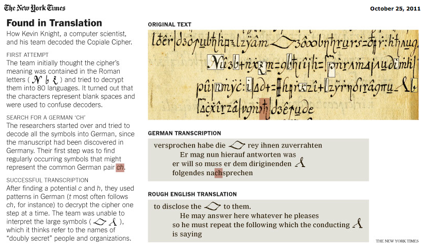John Markoff reporting for the NY Times – How 18th-Century Copiale Cipher Was Cracked:

It has been more than six decades since Warren Weaver, a pioneer in automated language translation, suggested applying code-breaking techniques to the challenge of interpreting a foreign language.
In an oft-cited letter in 1947 to the mathematician Norbert Weiner, he wrote: “One naturally wonders if the problem of translation could conceivably be treated as a problem in cryptography. When I look at an article in Russian, I say: ‘This is really written in English, but it has been coded in some strange symbols. I will now proceed to decode.’ ”
That insight led to a generation of statistics-based language programs like Google Translate — and, not so incidentally, to new tools for breaking codes that go back to the Middle Ages.
Now a team of Swedish and American linguists has applied statistics-based translation techniques to crack one of the most stubborn of codes: the Copiale Cipher, a hand-lettered 105-page manuscript that appears to date from the late 18th century. They described their work at a meeting of the Association for Computational Linguistics in Portland, Ore.
Discovered in an academic archive in the former East Germany, the elaborately bound volume of gold and green brocade paper holds 75,000 characters, a perplexing mix of mysterious symbols and Roman letters. The name comes from one of only two non-coded inscriptions in the document.
Kevin Knight, a computer scientist at the Information Sciences Institute at the University of Southern California, collaborated with Beata Megyesi and Christiane Schaefer of Uppsala University in Sweden to decipher the first 16 pages. They turn out to be a detailed description of a ritual from a secret society that apparently had a fascination with eye surgery and ophthalmology.
No comments:
Post a Comment